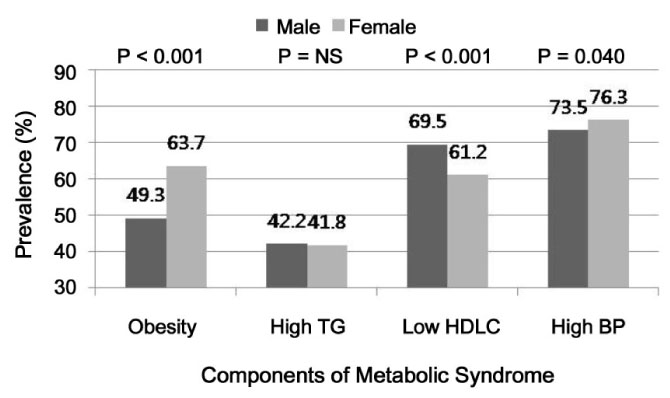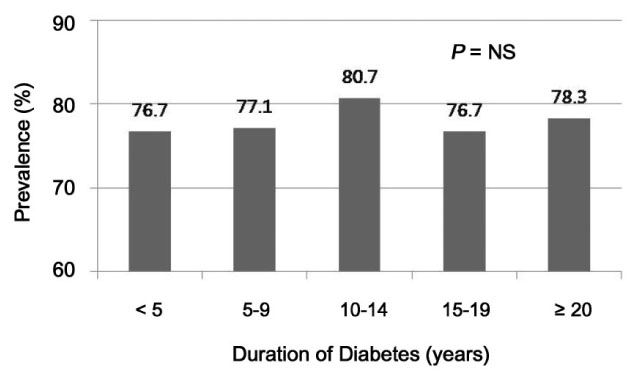Korean Diabetes J.
2009 Feb;33(1):40-47. 10.4093/kdj.2009.33.1.40.
Prevalence of the Metabolic Syndrome in Type 2 Diabetic Patients
- Affiliations
-
- 1Department of Endocrinology and Metabolism, Ajou University School of Medicine, Suwon, Korea. djkim@ajou.ac.kr
- 2Department of Internal Medicine, Seoul National University College of Medicine, Seoul National University Bundang Hospital, Seoul, Korea.
- 3Department of Internal Medicine, Kyung Hee University, East-West Neo Medical Center, Seoul, Korea.
- 4Department of Internal Medicine, Uijeongbu St. Mary's Hospital, Catholic University Medical College, Uijeongbu, Korea.
- 5Department of Internal Medicine, Yonsei University Wonju College of Medicine, Wonju, Korea.
- 6Department of Internal Medicine, Cheju National University Hospital, Cheju National University School of Medicine, Jeju, Korea.
- 7Department of Internal Medicine, Yeungnam University College of Medicine, Yeungnam University Hospital, Daegu, Korea.
- 8Department of Internal Medicine, Pusan Paik Hospital, College of Medicine, Inje University, Busan, Korea.
- 9Department of Internal Medicine, Chonbuk National University Hospital, Jeonju, Korea.
- 10Department of Internal Medicine, Chung-Ang University Hospital, Chung-Ang University College of Medicine, Seoul, Korea.
- 11Department of Internal Medicine, Dongsan Hospital, Keimyung University School of Medicine, Daegu, Korea.
- 12Department of Internal Medicine, St. Vincent's Hospital, Catholic University Medical College, Suwon, Korea.
- 13Department of Internal Medicine, Kyungpook National University Hospital, School of Medicine, Kyungpook National University, Daegu, Korea.
- KMID: 2222482
- DOI: http://doi.org/10.4093/kdj.2009.33.1.40
Abstract
-
BACKGROUND: The aim of this study was to analyze the prevalence of metabolic syndrome in Korean type 2 diabetic patients.
METHODS
A total of 4,240 diabetic patients (male 2,033, female 2,207; mean age 58.7 +/- 11.3 years; DM duration 8.9 +/- 7.6 years) were selected from the data of endocrine clinics of 13 university hospitals in 2006. Metabolic syndrome was defined using the criteria of the American Heart Association/National Heart Lung and Blood Institute and the criteria of waist circumference from the Korean Society for the Study of Obesity.
RESULTS
The prevalence of metabolic syndrome was 77.9% (76.7% of males, 78.9% of females). The average number of the components of metabolic syndrome was 2.4 +/- 1.1. Abdominal obesity was seen in 56.8% of the patients, hypertriglyceridemia in 42.0%, low HDL cholesterol in 65.1%, and high blood pressure in 74.9%. Abdominal obesity and high blood pressure were much more prevalent among females than males, and low HDL cholesterol was much more prevalent among males than females. The prevalence of metabolic syndrome was not different according to the duration of diabetes. Metabolic syndrome was strongly related with obesity (odds ratio, 6.3) and increased age (odds ratio in the over 70 group, 3.4).
CONCLUSION
The prevalence of metabolic syndrome was 77.9% in Korean type 2 diabetic patients. Its prevalence was greater in obese patients and in those over 40 years of age.
Keyword
MeSH Terms
Figure
Reference
-
1. Reaven GM. Role of insulin resistance in human disease. Diabetes. 1988. 37:1595–1607.2. Alberti KG, Zimmet PZ. Definition, diagnosis and classification of diabetes mellitus and its complications. Part I: diagnosis and classification of diabetes mellitus provisional report of a WHO consultation. Diabetic Med. 1998. 15:539–553.3. Expert panel on detection, evaluation, and treatment of high blood cholesterol in adults. Executive summary of the third report of the national cholesterol education program (NCEP) expert panel on detection, evaluation, and treatment of high blood cholesterol in adults (adult treatment panel III). JAMA. 2001. 285:2486–2497.4. American college of endocrinology. Consensus statement on guidelines for glycemic control. Endocr Pract. 2002. 8:suppl 1. S5–S11.5. Alberti KG, Zimmet P, Shaw J. The metabolic syndrome - a new worldwide definition. Lancet. 2005. 366:1059–1062.6. Grundy SM, Cleeman JI, Daniels SR, Donato KA, Eckel RH, Franklin BA, Gordon DJ, Krauss RM, Savage PJ, Smith SC Jr, Spertus JA, Costa F. American Heart Association. National Heart, Lung, and Blood Institute. Diagnosis and management of the metabolic syndrome: an American Heart Association/National Heart, Lung, and Blood Institute Scientific Statement. Circulation. 2005. 112:2735–2752.7. Lee S, Park HS, Kim SM, Kwon HS, Kim DY, Kim DJ, Cho GJ, Han JH, Kim SR, Park CY, Oh SJ, Lee CB, Kim KS, Oh SW, Kim YS, Choi WH, Yoo HJ. Cut-off Points of Waist Circumference for Defining Abdominal Obesity in the Korean Population. Korean J Obes. 2006. 15:1–9.8. Kim DJ, Park HS. Metabolic syndrome. Korean Society for the study of Obesity. Clinical Obesity. 2008. 3rd ed. Seoul: Korea Medical Book Publisher Co.;249–272.9. Chung HW, Kim DJ, Jin HD, Choi SH, Ahn CW, Cha BS, Lee HC, Huh KB. Prevalence of Metabolic Syndrome according to the New Criteria for Obesity. J Korean Diabetes Assoc. 2002. 26:431–442.10. Ford ES, Giles WH, Dietz WH. Prevalence of the metabolic syndrome among US adults: findings from the third National Health and Nutrition Examination Survey. JAMA. 2002. 287:356–359.11. Korea Centers for Disease Control and Prevention. In-depth analyses for metabolic syndrome with data of the 3rd Korea National Health and Nutrition Examination Survey (2005). 2007. 205–238.12. Lobo RA. Metabolic syndrome after menopause and the role of hormones. Maturitas. 2008. 60:10–18.13. Isomaa B, Almgren P, Tuomi T, Forsén B, Lahti K, Nissén M, Taskinen MR, Groop L. Cardiovascular morbidity and mortality associated with the metabolic syndrome. Diabetes Care. 2001. 24:683–689.14. Alexander CM, Landsman PB, Teutsch SM, Haffner SM. Third National Health and Nutrition Examination Survey (NHANES III). National Cholesterol Education Program (NCEP). NCEP-defined metabolic syndrome, diabetes, and prevalence of coronary heart disease among NHANES III participants age 50 years and older. Diabetes. 2003. 52:1210–1214.15. Moon MK, Cho YM, Jung HS, Kim KW, Park YJ, Jang HC, Shin CS, Park KS, Kim SY, Lee HK. The prevalence of metabolic syndrome and its relation with chronic complications in Korean type 2 diabetic patients. Korean J Lipid Atherosclerosis. 2003. 13:382–391.16. Edwards KL, Austin MA, Newman B, Mayer E, Krauss RM, Selby JV. Multivariate analysis of the insulin resistance syndrome in women. Arterioscler Thromb. 1994. 14:1940–1945.17. Rhee SY, Chon S, Oh S, Kim SW, Kim JW, Kim YS, Woo JT. Insulin Secretion and Insulin Resistance in Newly Diagnosed, Drug Naive Prediabetes and Type 2 Diabetes Patients With/Without Metabolic Syndrome. J Korean Diabetes Assoc. 2006. 30:196–206.
- Full Text Links
- Actions
-
Cited
- CITED
-
- Close
- Share
- Similar articles
-
- Sex differences in Risk of Cardiovascular Disease, Depression and Self-Care Activities in Type 2 Diabetes with Metabolic Syndrome
- Differences in Prevalence and Risk Factors of the Metabolic Syndrome by Gender in Type 2 Diabetic Patients
- Mental Health and Self-care Activities according to Perceived Stress Level in Type 2 Diabetic Patients with Metabolic Syndrome
- Clinical Predictive Factors for Metabolic Syndrome in Obese Children and Adolescents
- The Relations between Diabetic Dietary Compliance, Dietary Intake, and Physical Activity and the Prevalence of Metabolic Syndrome (MS) in Type 2 Diabetic Patients



